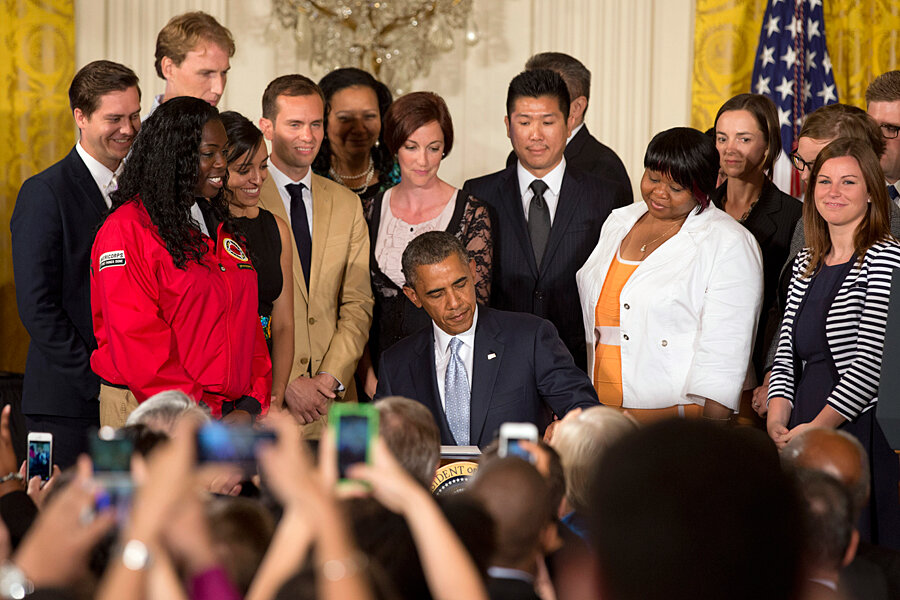Student loan relief 101: More borrowers won't pay over 10 percent of incomes
Loading...
On Monday, President Obama took executive action that will allow millions more people to cap their student loan payments at 10 percent of their annual incomes – an option that most, but not all, student borrowers have had since 2010.
He also urged Congress to approve a bill that Sen. Elizabeth Warren (D) of Massachusetts has sponsored, and that the Senate plans to take up this week, which would allow some 25 million borrowers to refinance student loans at lower rates. And he announced a number of other measures around communication and education for student borrowers, to allow them to make more informed decisions and take advantage of the options open to them.
"At a time when college has never been more important, it’s also never been more expensive," Mr. Obama said in his weekly address on Saturday, in which he announced the executive actions he planned to take without congressional sign-off. He defined the choice before Congress as "protect young people from crushing debt, or protect tax breaks for millionaires."
In looking at the student debt crisis, and the president's plan, here's what's helpful to understand.
What is Obama changing, and who will it affect?
In his State of the Union address back in January, Obama said he'd use executive action when Congress didn't act quickly enough, and that's what he's doing here. The memorandum he signed Monday directs the Education Department secretary to propose regulations that would extend the income caps for student borrowers, set in 2010 legislation, to students who borrowed before 2007 or who haven't taken out loans since October 2011, and hence aren't covered by that "Pay as you earn" (PAYE) option.
Under PAYE, borrowers can cap their loan payments at 10 percent of their yearly incomes. Any unpaid loans are forgiven after 20 years (or after 10 years for those in public-service jobs). The White House estimates that this action will extend the benefits to about 5 million borrowers, and the secretary is directed to have the option available to borrowers by the end of 2015 at the latest.
The administration also announced it will renegotiate its contracts with companies that service federal loans to give more incentives for borrowers to repay loans on time and to reduce payments for those servicers when loans enter delinquency or default. And it will work with Intuit Inc. and H&R Block to communicate options about federal loan repayment options to borrowers during tax filing time. The Department of Education also plans to test new ways to reach 2.5 million borrowers at the greatest risk for default on student loans.
Is there an example?
In one example the White House provided, a 2009 graduate earning $39,000 a year, with a student loan debt of $26,500, would see his or her monthly payment reduced by $126 a month, or about $1,500 a year.
Who is pleased by these actions, and who is objecting?
Obviously, the 5 million or so borrowers who can now take advantage of these more generous income-based repayment terms will benefit the most, particularly those who borrowed large amounts – often students who took on debt to pay for grad school. The actions are likely to be popular, in general, with young people (which already has some Obama critics suggesting that this is purely an election-year ploy to win points among a key demographic).
But the plan has its critics, even among those who support income-based repayment options for student loans. All student borrowers – including those 5 million likely to be affected by this change – already had access to some form of income-based repayment, notes Jason Delisle, director of the New America Foundation's Federal Education Budget Project. Under the previous terms, those who didn't have access to PAYE could still do income-based repayment where they paid 15 percent of their incomes, after a $17,500 exemption, and had their debt forgiven after 25 years. In many ways, he says, those terms made much more sense, and were more fair, especially for students borrowing large sums of money to go to grad school, who are very unlikely to be able to pay off their loans in 10 or 20 years even with high incomes.
"Income-based repayment is vital, and it's important we have it, but it's very important we get the terms right," says Mr. Delisle. "The payments are too low and the terms are too short for someone who's borrowed to go to grad school."
Republicans in Congress, meanwhile, say Obama's actions will do nothing to help students find jobs – which they say should be the focus. Some higher education experts note that the more troubling issue is the spiraling cost of college tuition, which also won't be affected by Obama's actions on student loans. "It's dealing with the symptoms and not the disease," says Richard Vedder, director of the Center for College Affordability.
What is the Senate bill Obama is pushing, and how likely is it to pass?
The Senate bill sponsored by Senator Warren would allow borrowers to refinance student loans – both federal and private loans – at lower rates. An estimated 25 million Americans would be affected, and the bill would cost about $58 billion over 10 years, covered in the legislation by a new tax on individuals earning high incomes.
Given the cost to the government and the new tax, it's unlikely the bill as written would pass Congress (particularly the Republican-led House). And given the prevalence of income-based repayment options, says Delisle, focusing on interest rates is somewhat irrelevant for most borrowers.








